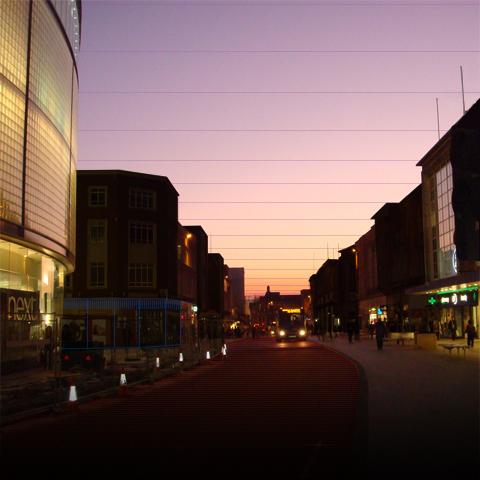Why Mary Portas is not quite right about the High Street - more coffee bars, community centres and gyms are not the solution!

Mary Portas has just submitted her report of 28 recommendations to the government on how to tackle the declining fortunes of our High Streets. A lot of what she says makes some degree of sense, but a number of the policies seem somewhat defeatist and totally against smart, small independent retail businesses.
I have lived in various parts of this land, in towns and cities of varying sizes, and I have witnessed first-hand the changes to our local High Streets, and I have slightly different answers and recommendations for how the High Street should tackle the current issues.
To start off with, we need to be aware of the full spectrum of key considerations for shopping:
- Price - Online is best obviously, Malls and Supermarkets are usually cheaper than city-centre retailers too
- Range - Again Online is best - most choice at the best prices, next come the larger retailers, and again the High Street typically comes last
- Availability - It’s usualy easiest to find availability online, then in larger shops - depends on size of Town really as to what is available on the High Street
- Convenience - This largely depends on where you live, but Malls are usually located where they are easy to get to - and have free parking, whilst town centres are more congested and you have to pay for parking - if you can find a space; online of course is always at your fingertips - there are other factors here including weather and transport / traffic congestion in your area
- Facilities - Here the Malls come into their own really - Multi-screen cinemas, restaurants, amusements, all the shops and various family-friendly amenities and services all under one roof - antiquated town centres with poorly tended toilet facilities and spaced out amenities cannot compete, of course online comes with its own home comforts
- Service - It largely depends on who you do business with - but increasingly you get better service online - better loyalty schemes, better packaging, and increasingly more delivery options, now with more flexible locker collection solutions (like Collect+ and ByBox), as well house-sitters (courtesy of WaitingIn.co.uk) if you need someone to wait in for a furniture delivery or similar while you’re at work (last year 800 million hours were lost by customers waiting for deliveries; 8 million individuals took time off work)
- Flexibility - Even Malls cannot compete with the any-time shopping of Online; Malls tend to be open a lot later than the High Street though
- Sense of Occasion - shopping themes, events, performances and special occasions - these are things which Malls, Selfridges and The Apple Store excel at - The High Street lags way behind in this respect
We further need to understand what really are the core issues for the typical High Street - both for retailers and shoppers, and how and why Super-Malls like Westfield and online retailers like Amazon are increasingly winning customers away from the Hight Street. We also need to understand how retailers like Apple and Selfridges create their own unique very successful flavours of Destination Shopping.
Back to the Hight Street then and its decline - what has changed? And what might be done to reverse the decline. If we take the key market town for North Devon - Barnstaple, how has this changed over the years? It benefits from a permanent and very active Pannier Market Hall with a daily calendar of different types of market days - general, arts and crafts, food days etc. - this though has had little impact on the turnaround of various units on the High Street - although it does encourage certain shopper to come into town on specific days. The decline of Music shops has been most evident, as wel as furniture stores, there is only one proper bookshop remaining, there is no longer a dedicated wine shop, and Woolworths disappeared into the central mall, before disappearing entirely. For a town of largely shoe shops, estate agents and charity shops, the biggest current trend seems to be the growth of coffee shops and pizza restaurants - and of course mobile phone shops! I don’t see how Mary Portas could think Barnstaple could handle yet more coffee shops? There are also sufficient gyms and community centres close to the centre. Only one set of old fashioned Victorian public toilets though!
Barnstaple’s nearest big City is Exeter - which is supposedly the most archetypal Hight Street in the UK as it is composed pretty much entirely of major retailers / chain shops - as opposed to Huddersfield, where I belive there is still a significant sprinkling of independent retailers. It would be interesting to see attendance comparisions with each, to see whether independents result in greater footfall, although footfall is not nearly as important and overall spend. Up and down the UK, even in Central London - along Wigmore Street and Edgware Road, you can see the ugly gaping wounds of empty retail units - there are already coffee shops on every corner, as well as pizza restaurants, betting shops and fast food outlets. Clothing shops and furniture stores in particular seem to be in significant decline.
Three of the key issues that affect retailers are:
- Rent - Landlords have been particularly greedy and inflexible of late - high rents with no room for negotiation
- Business Rates - High Street business rates are punishing even for some of the chains
- Supply Access - Stores now have hugely restricted times for when they can re-stock themselves
- Traffic Planning - most British town centres are poorly planned for traffic, tend to be congested and difficult to enter or leave!
- Town Centre Parking - Cost and scale of in-town parking has become prohibitive and discouraging for many shoppers
The cost of all of these elements has gone up over the years, as the flexibility has gone down. Greedy landlords have enforced upward only rent reviews, and most seem quite happy with empty units - versus occupation at a more reasonable rate. If you’ve ever tried to drive into Bath for shopping, you realise the 2 key enemies of High Street shopping - traffic congestion and scarcity and price of parking - it’s nigh on impossible to find a parking space, and if you intend to stay for the day, you pay almost as much as for your shopping.
So driving and parking are issues for city-centre shopping, but another key facet that Mary Portas does not focus on is the typically poor service and poor retail environment offered up by most High Street retailers. If you shop somewhere like Westfield - they have numerous toilets and changing facilities, as well as amusements and crèches for kids - and other amusements and ameneties for pretty much the whole family - everyone taken care of under one roof, and in a weatherproof and safe environment. Typically personal security / safety is much higher in a Mall than in a town centre - there is better surveillance, more security officers and quicker response times - for far far fewer incidents.
People also go to a Mall partly because of a sense of occasion, and range of facilities offered - most city centres have few and far between toilets, no baby changing facilities or crèches, and no sense of theatre or occasion. Selfridges has daily in-store events, including over the years - some truly magnificent large-scale themes like the Brazilian and Japanese shopping days - with associated cultural events, exhibitions, parades, demonstrations etc. Apple does this on a smaller scale with really smart retail environments split up into thematic interactive spaces - with a retail assistant always within reach, various service areas, and even a theatre which puts on shows, gigs and numerous educational and demonstration events. For me, the Apple experience is truly exemplary - every other staff member has a handheld EPOS terminal - so you can pay pretty much anywhere in the store - compare this with the old-fashioned High Street retailers where you queue up endlessly at some corner counter.
I myself use real-world stores increasingly as showrooms (with obvious exceptions; e.g. most clothing) - to go and check out and see / touch / sample the wares - before buying online - as it’s usually less hassle online, and you have a greater range of colours and sizes - and pay a lower price. I have often been left waiting for 10-20 minutes up to nearly an hour, while some inept shop assistant searches the storeroom for my size or colour. Also - if it’s a large item, I don’t necessarily want to lugg it home on the Tube - I would rather have it delivered to my home. I’m not always blaming the staff - frequently it is the inventory and retail systems and structures that are at fault - but typically there is too much active waiting around in shops - and endless queues.
High Street retailers have been very slow and poor to react to the malls and to online shopping - if they are going to charge more for their wares, they need to provide much better service, and give you a much better reason for attending their store. We already have a great example of how this is done well - courtesty of Boxfresh’s Roger Wade - who recently launched the world’s first High Street Pop-Up Mall - Shoreditch’s Boxpark - an ingenious retail destination made from clevery prepared and integrated container units. Boxpark does not really solve the parking issue, but it does provide a very flexible rental contract - 1 to 5 years, and minimal rates charges - the adjoining amenities also provide a quasi-mall experience in compact form.
For the High Street to recover, Local Councils need to be less greedy on the rates and parking revenues, and more flexible in their arrangements with retailers. Landlords need to be more reasonable with rents, and need to offer smaller rental units, with more flexible short-term leasing options.
As for the retailers - they need to provide goods and services that the public actually wants, at a price which is justified by the experience. If something is really great, people are typically willing to pay a little more for it. Retailers also need to team up and provide more reasons for shopping - in terms of performances, events and special themed occasions.
The High Street will never compete on price or convenience with the Internet, nor can it provide the compact, all-encompassing, safe experience of the Malls - it has to offer something different, something fresh. We need an enterprising council to work with local landlords and produce something like Camden Lock Village - lots of small units, surrounded by seating and food stalls, or another Boxpark - which contains its own amenities on its upper level. Out of town shopping will always be about larger-scale shops, bigger units. City Centre shopping can revert to a more market-stall-like template, but done in a modern, enterprising way. For this to work, rents have to be flexible, offering relatively short start-up periods for trial / pop-up stores. But none of this will work, if the greedy councils continue to make it difficult for people to get into town and park reasonably close to those stores.
Boxpark has adopted its own opening times - typically 12:00 - 20:00 - which are much closer to Camden Market, and more in keeping with modern life. People tend to work longer these days and on more flexible hours, so they need retailers to be open longer so they can access them. Store retailers need to realise too that times have changed - and that opening 09:00 to 18:00 is no longer really an option. The Internet will be dominant because of its 24/7 access, range, price and flexibility. Every year we have new more pin-point delivery services which now can deliver within an hour window - at a premium of course. For those that don’t like waiting around, there are numerous click-and-collect services in operation, as well as the lockers which I mentioned earlier. I’ve had some negative feedback on Collect+, and the nearest ByBox lockers to me are at Victoria Station - so these services are not quite perfect yet - I do expect them to be improving though, and the Amazon / 7-eleven hookup seems an inspired idea - we just need more of those 24 hour snack shops in the UK!
There is still potential for the High Street, but it needs a lot of help, and it needs to change fast before we start encountering American-styles towns and cities - where retail is limited to Strip-Malls on their outskirts. As this change requires a significant change in attitude from Councils, Landlords and the Retailers themselves, it’s quite unlikely that such an alliance will form, and even less likely that it will actually put something into action any time soon. For now we need to rely on pioneers like Roger Wade to show us the way - if the government wants change, it needs to enforce it, starting today. If they leave it too late, we will all have to pick up the tab of 1,000s of more bankrupt retailers.
The other thing that no one is focusing on much is that there is very little money currently in our economy. We are most definitely in the trhows of a double-dip recession and businesses are going bust, as much less money is being spent. Whatever liquidity is being introduced into the system via Quantitive Easing is disappearing well before it trickles into shoppers’ pockets - it seems that the banks and financial institutions are still siphoning off more than their fair share - it is however a vicious cycle, as these banks rely on the success of their commercial divisions, and with funds being siphoned off, less transactions are being made every which way. Something obviously has to change, but who has all the money? Mulberry is up 44% on the year, and Burberry are up 30% when most are shrinking; I don’t even need to guess to add what Apple’s revenues might be - yet at the same time dozens of well-known High Street Brands are going bust or are endangered - these include Barratts Shoes, La Senza, Blacks / Millets, JJB Sports, Game, HMV and Waterstones. 2011 Christmas retail figures are down - many of these stores really needed to take the gamble with super early sales, but too few have done. For many, the January sales could well be their last.
My Top 10 Recommendations!:
- Lower and more flexible rental agreements for small retailers; rental periods as short as 6 months
- Lower Business Rates / Rebates
- More availability of smaller retail units
- More in-town parking concessions
- Improved parking facilities
- Improved traffic routing
- Appointment of retail consultant to ensure correct mix of stores and sufficient provision of complementary amenities
- Recommend adoption of similar systems to Camden Lock Village and Boxpark
- High Street Retailers need to provide more extended hours shopping
- High Street Retailers need to provide better shopping experiences a la Apple and Selfridges - themes, events, services, ’theatre’

Did you find this content useful?
Thank you for your input
Thank you for your feedback
Upcoming and Former Events
Affino Innovation Briefing 2024
Webinar - Introduction to Affino's Expert AI Solutions - Session #2
Webinar - Introduction to Affino's Expert AI Solutions - Session #1
PPA Independent Publisher Conference and Awards 2023
Meetings:
Google Meet and Zoom
Venue:
Soho House, Soho Works +
Registered Office:
55 Bathurst Mews
London, UK
W2 2SB
© Affino 2024


















